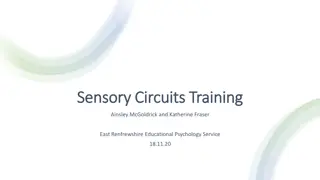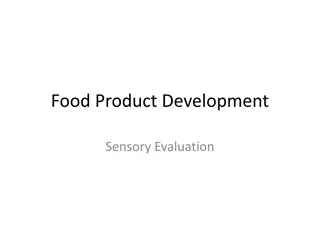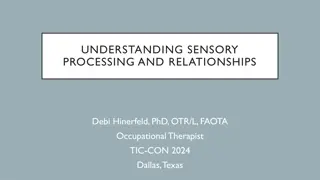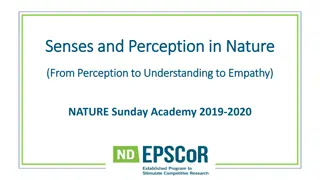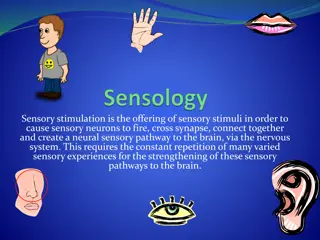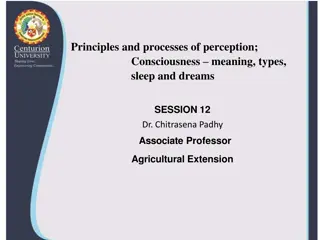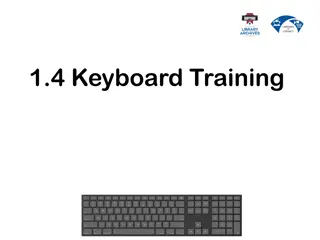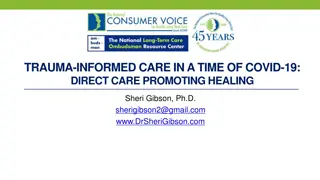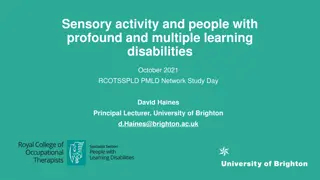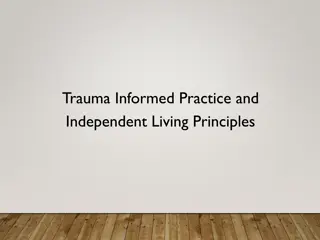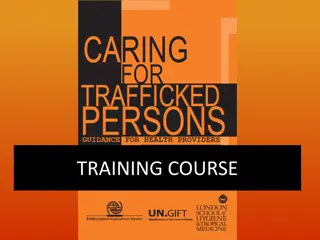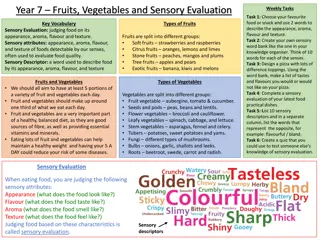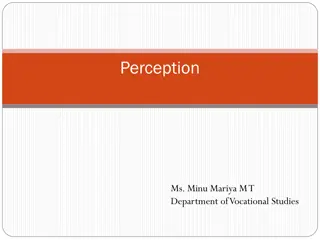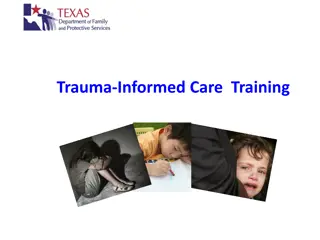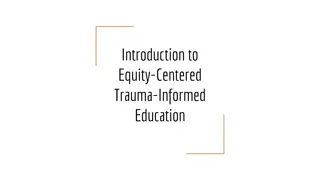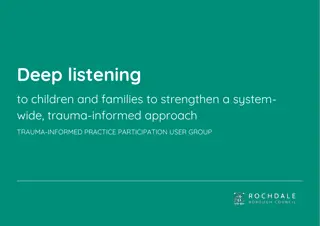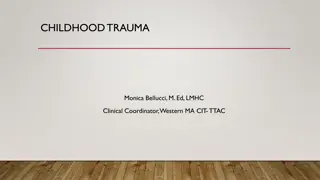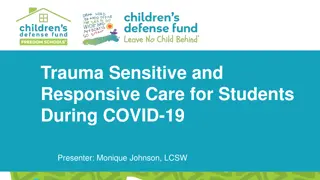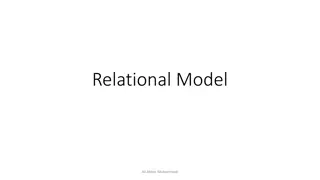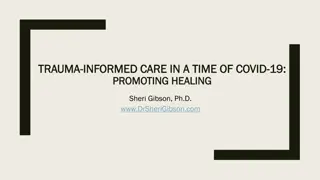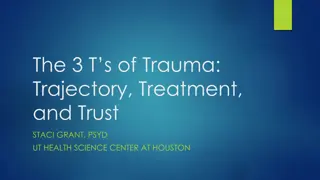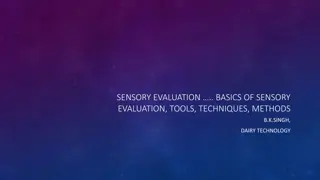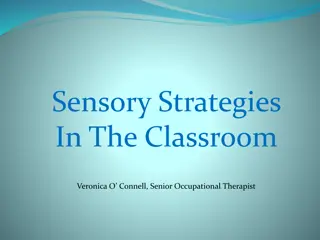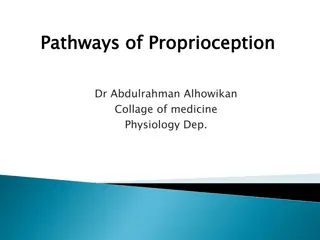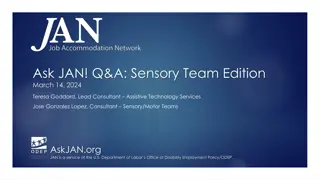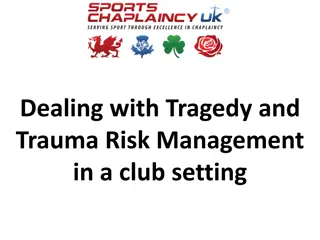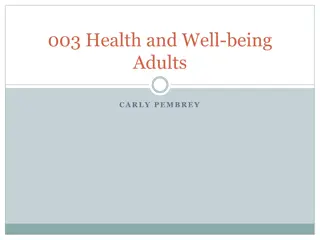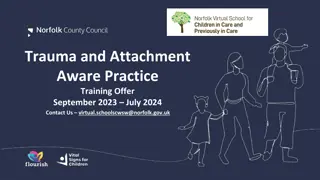Understanding Trauma-Informed Care: Keys to Recognition and Sensory Perception
Trauma-Informed Care emphasizes acknowledging the widespread impact of trauma, recognizing its signs, integrating trauma knowledge into practices, and preventing re-traumatization. The care approach focuses on sensory perception, understanding brain behavior, and recognizing how trauma affects individuals' responses to sensory inputs.
Download Presentation

Please find below an Image/Link to download the presentation.
The content on the website is provided AS IS for your information and personal use only. It may not be sold, licensed, or shared on other websites without obtaining consent from the author. Download presentation by click this link. If you encounter any issues during the download, it is possible that the publisher has removed the file from their server.
E N D
Presentation Transcript
TRAUMA INFORMED CARE Mandy A. Davis, LCSW, PhD madavis@pdx.edu 503-725-9636 Stephanie Sundborg, MS ssund2@pdx.edu 503-931-0536
3 Trauma Informed Care A program, organization, or system that is trauma- informed: 1. Realizes the widespread impact of trauma and understands potential paths for recovery; 2. Recognizes the signs and symptoms of trauma in clients, families, staff, and other involved with the system; 3. Responds by fully integrating knowledge about trauma into policies, procedures, and practices; and 4. Seeks to actively resist re-traumatization (SAMHSA, 2014)
4 Trauma Informed Care A program, organization, or system that is trauma- informed: 1. Realizes the widespread impact of trauma and understands potential paths for recovery; 2. Recognizes the signs and symptoms of trauma in clients, families, staff, and other involved with the system; 3. Responds by fully integrating knowledge about trauma into policies, procedures, and practices; and 4. Seeks to actively resist re-traumatization (SAMHSA, 2014)
5 Environment Brain Behavior Input from the environment vision, hearing, smell, taste, touch In-between stuff mental activities Perception, attention, memory, learning WHY Output in the environment Running, yelling, fighting, eating, listening, speaking,
6 Sensory Perception Bottom Up Touch First of five senses to develop and most prominent at birth Critical part of growth and nurturing Auditory Can be powerful triggers Studies show trauma survivors are more aware of oddball sounds earlier Taste 2,000-5,000 taste buds Four types of taste: Olfactory (Smell) Can detect around 10,000 smells Only sensory input that is directly connected to limbic system (memory & emotion) Visual Least accurate of all senses Does not reach full adult functioning until age four
8 Sensory / Perception and the Trauma brain More sensitive to incoming sensory information sounds are louder, smells are stronger. Sensory information act as triggers Top down input may be distorted not available Connecting to behavior: Do you notice survivors are more aware or bothered by sensory input?
9 Attention and the Trauma brain Selective attention is worse in general but better for threatening stimuli Divided attention hyper vigilance not wanting to inhibit distractors Connecting to behavior: Do you notice survivors have a harder time focusing attention? Are they easily distracted?
10 Memory and the Trauma brain Short term (Working memory) isn t very good frontal lobe activation is decreased LT Declarative memory is usually impaired damage to hippocampus and problems with working memory HOWEVER LT - Implicit memory is strong for threatening stimuli Connecting to behavior: Do survivors forget appointments, treatment plans, what was discussed last time? But, is their memory for threat situations or details good?
11 Executive Function and the Trauma brain Frontal lobe function is impaired affecting judgment, decision making, planning, reasoning Impulse control is more difficult Needed regulation is not online - attention and emotion can get out of wack Anxiety related, perseverative loops - OCD Connecting to behavior: Do survivors perseverate, fixate? Do they show problems with impulse control? Struggle with making decisions or planning?
12 Top Down Processing Pre-existing knowledge is used to rapidly organize features into a meaningful whole Past experiences, motives, contexts, or suggestions prepare us to perceive in a certain way (Perceptual Expectancy) We don t see things as they are. We see them as we are Anais Nin
15 Mezzanine Downstairs Brain Upstairs Brain Incoming sensory Orienting attention Reflexive Perception (e.g. startle) Long-term memory Learning Judgment Problem solving Decision making Perception Selective attention Working Memory Response
16 Opportunity to make sure attention is focused? Perception isn t distorted? Info is getting into short term memory? With so much going on in this room, I know it can be difficult to stay focused on me, but if you could give me your attention for just a few minutes I know I just gave you a lot of information, can you tell me your understanding of next steps Opportunity to help navigate, control, filter sensory input What to expect We know the noise in the waiting area can be overwhelming perhaps bringing headphones Stress Response Draw on context, experience, and LT memory to shape incoming info. If needed, create new stories / memories to replace old ones Remember last time this happened, you were able to XYZ
17 Stress Response . Selective Attention and working memory Offers rational thinking, planning, decision making, sense making Incoming sensory information If stress response warranted HPA axis initiates Memory formation checks memories for context Considers sensory info for real or perceived danger Illustration: Hallorie Walker Sands
18 Dominant at birth Developing slower ~ 18-24 months More logical, analytical, and sequential Focuses on details construct narratives Sensory experiences no language Emotional Processing Relational hemisphere focused on attachment
19 Cortisol and other Brain Chemicals Norepiniphrine (NE) Alertness / arousal / attention fight/flight (SAM sys chemical) Solidifying threat memories Cortisol fight/flight (HPA axis chemical) Damages hippocampus (memory) Needed to shut off stress response neg feedback loop Lower levels in PTSD Serotonin (5HT) Dampen NE firing Reduces sensory stimulation in amygdala only in presence of cortisol Reduced levels in PTSD, depression
20 Cortisol and other Brain Chemicals GABA (benzodiazepine) Inhibitory NT reduces excitatory activity Reduces re-experiencing / hyperarousal Frontal lobe squirts GABA into amygdala Impaired in PTSD Endogenous Opiates Analgesia Related to dissociative symptoms Acute stress response elevates secretion of opioids Chronic stress response may lead to lower concentration of opioids
21 When Trauma Happens . Freeze, Flight, Fight, Fright
22 When Trauma Happens . Chronic Trauma, Complex trauma overtime Central Nervous system becomes unbalanced Parasympathetic Nervous Sys: Rest and Digest Sympathetic NS: Arousal system Fight or Flight
23 Neurobiology Take Aways Simple to complex Survival mechanisms act first and faster than the thinking brain. When we are threatened brain moves resources away from thinking toward survival. Our brain learns patterns. Fire-together-wire-together.
24 Neurobiology Take Aways Attention can be a problem: Amygdala in survivors is hyper-vigilant scanning for real or perceived threat; attentional control from frontal lobe is decreased Communication is challenging: dominance of RH Decreased verbal (left hemisphere) hypersensitive to nonverbal (right hemisphere) prone to misinterpret. Memory is impaired damage to hippocampus due to excess cortisol: Explicit memory (hippocampus) facts, stories, pictures impaired Implicit memory (amygdala acute trauma) often clear and sharp
25 Stretch
27 Principles of Practice With a foundation of awareness and understanding, organizations can strive to reflect three central principles of TIC, by creating policies, procedures, and practices that: create safe context, restore power, and value the individual.
28 Trauma Informed Care Trauma Informed Care (TIC) recognizes that traumatic experiences terrify, overwhelm, and violate the individual. TIC is a commitment not to repeat these experiences and, in whatever way possible, to restore a sense of safety, power, and worth Understanding the Impact of Historical Trauma Commitment to Trauma Awareness Agencies demonstrate Trauma Informed Care with Policies, Procedures and Practices that Create Safe Context through: Physical safety Trustworthiness Clear and consistent boundaries Transparency Predictability Choice Restore Power through: Choice Empowerment Strengths perspective Skill building Value the Individual through: Collaboration Respect Compassion Mutuality Engagement and Relationship Acceptance and Non- judgment
29 What is required to Provide TIC? Secure, healthy adults; Good emotional management skills; Intellectual and emotional intelligence; Able to actively teach and be role model; Consistently empathetic and patient; Able to endure intense emotional labor; Self-disciplined, self-controlled, and never likely to abuse power.
30 The Reality We have a workforce that is under stress. We have a workforce that absorbs the trauma of the consumers. We have a workforce populated by trauma survivors. We have organizations that can be oppressive. All of this has an impact We have organizations that come to resemble the behavior we re trying to help.
31 Safety Emotional Management Dissociation Systematic Error Authoritarianism Impaired Cognition Impoverished relationship Disempowered Helplessness Increased Aggression Unresolved Grief Loss of Meaning Adapted from Sandra Bloom s Sanctuary Model


